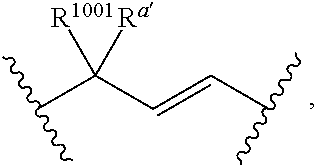Compositions and methods for the treatment of inflammatory disease
a technology for inflammatory diseases and compositions, applied in the field of compositions and methods for the treatment of inflammatory diseases, can solve the problems of liver toxicity, unwanted side effects, weight gain,
- Summary
- Abstract
- Description
- Claims
- Application Information
AI Technical Summary
Problems solved by technology
Method used
Image
Examples
example 1
Synthesis of Bromoallylic Alcohol Reagent 403
[0517]
[0518]A mixture of propargyl alcohol (401; 3.26 g, 58.2 mmol), N-bromosuccinimide (11.2 g, 62.9 mmol) and silver(I) nitrate (1.00 g, 5.88 mmol) in acetone (100 mL) was stirred at room temperature for 2 h. After this time, the reaction mixture was concentrated and the residue redissolved in iced water (150 mL) and diethyl ether (200 mL), the aqueous layer was removed and extracted with diethyl ether (100 mL). The combined organic layers were washed with brine (100 mL) and dried over sodium sulfate, filtered and concentrated, to give 7.83 g of bromopropargylic alcohol 402 as an orange / yellow oil which was used crude in the next step.
[0519]A solution of aluminum trichloride (7.70 g, 57.7 mmol) in diethyl ether (40 mL) was added dropwise to a stirred suspension of lithium aluminum hydride (4.38 g, 115 mmol) in diethyl ether (40 mL) at −5° C., followed by the careful addition of bromopropargylic alcohol (402; 7.38 g, from step 1). The mi...
example 2
Synthesis of Phosphonate Building Blocks 411 and 411a
[0520]
[0521]Synthesis of Compound 405. A solution of methyl 4-(chlorocarbonyl)butanoate (404, 23.0 g, 139 mmol) in methylene chloride (40 mL) was added dropwise over 10 min to a suspension of aluminum chloride (22.3 g, 167 mmol) in methylene chloride (130 mL) at 0° C. The mixture was then transferred to a dropping funnel and added to a solution of bis(trimethylsilyl)acetylene (23.7 g, 139 mmol) in methylene chloride (70 mL) at 0° C. The mixture was stirred at 0° C. for 3 h, then poured into a mixture of ice (150 mL) and 0.1 N HCl (150 mL), stirred for 5 min and then diluted with diethyl ether (450 mL) and water (100 mL). The aqueous layer was separated and extracted with diethyl ether (2×150 mL). The combined organic layers were washed with water (300 mL), saturated aqueous sodium bicarbonate (300 mL) and brine (300 mL), dried over sodium sulfate, filtered and concentrated. Purification by flash chromatography (silica, 90:10 hexan...
example 3
Synthesis of (S)-ethyl 5-hydroxyhept-6-ynoate 412
[0529]
[0530]Compound 408a (26.7 g, 104 mmol) and ammonium chloride (5× molar excess) were dissolved in tetrahydrofuran (15 mL) at 0° C. and the tetrabutylammonium floride (5× molar excess of a 1.0 M solution in tetrahydrofuran) was added. The reaction mixture was stirred for 2 h at room temperature. After this time, the reaction was diluted with water (20 mL) and extracted with diethyl ether (2×45 mL). The combined organic layers were washed with brine, dried over sodium sulfate, filtered and concentrated. Purification by silica plug filtration (silica, 95:5 to 80:20 hexanes / ethyl acetate) afforded 412 (15.9 g, 83%) as a yellow oil.
PUM
| Property | Measurement | Unit |
|---|---|---|
| temperature | aaaaa | aaaaa |
| temperature | aaaaa | aaaaa |
| temperature | aaaaa | aaaaa |
Abstract
Description
Claims
Application Information
 Login to View More
Login to View More - R&D
- Intellectual Property
- Life Sciences
- Materials
- Tech Scout
- Unparalleled Data Quality
- Higher Quality Content
- 60% Fewer Hallucinations
Browse by: Latest US Patents, China's latest patents, Technical Efficacy Thesaurus, Application Domain, Technology Topic, Popular Technical Reports.
© 2025 PatSnap. All rights reserved.Legal|Privacy policy|Modern Slavery Act Transparency Statement|Sitemap|About US| Contact US: help@patsnap.com



